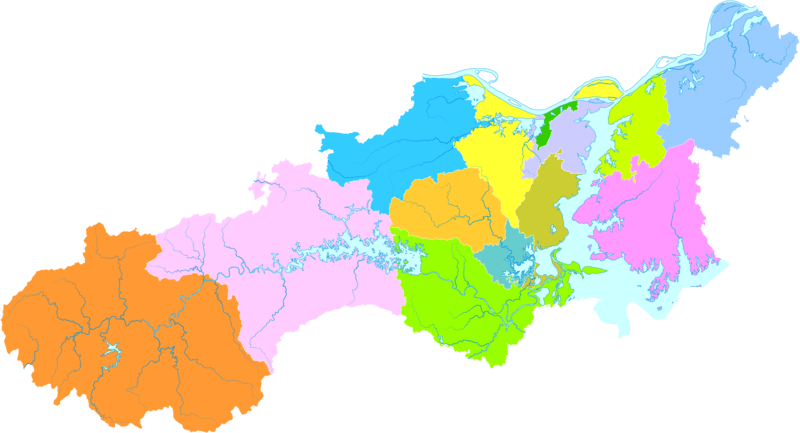Jiujiang
Jiujiang (Chinese: 九江), formerly transliterated Kiukiang[2] or Kew Keang, is a prefecture-level city located on the southern shores of the Yangtze River in northwest Jiangxi Province, People's Republic of China. It is the second-largest prefecture-level city in Jiangxi province after the provincial capital Nanchang. Jiujiang literally means "nine rivers".
Jiujiang 九江市 Kiukiang | |
|---|---|
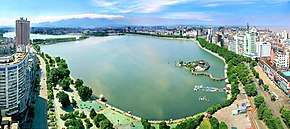 Jiujiang panorama | |
.png) Location of Jiujiang City jurisdiction in Jiangxi | |
| Coordinates (Jiujiang municipal government): 29°39′40″N 115°57′14″E | |
| Country | People's Republic of China |
| Province | Jiangxi |
| Seat | Municipal seat |
| Government | |
| • Party Secretary | Yang Weidong |
| • Mayor | Lin Binyang |
| Area | |
| • Prefecture-level city | 18,823 km2 (7,268 sq mi) |
| • Urban | 598 km2 (231 sq mi) |
| • Metro | 598 km2 (231 sq mi) |
| Elevation | 20 m (70 ft) |
| Highest elevation | 1,794 m (5,886 ft) |
| Population (2010 census) | |
| • Prefecture-level city | 4,728,778 |
| • Density | 250/km2 (650/sq mi) |
| • Urban | 704,986 |
| • Urban density | 1,200/km2 (3,100/sq mi) |
| • Metro | 704,986 |
| • Metro density | 1,200/km2 (3,100/sq mi) |
| Time zone | UTC+8 (China Standard) |
| ISO 3166 code | CN-JX-04 |
| Website | www |
| Jiujiang | |||||||||||||||||||||
|---|---|---|---|---|---|---|---|---|---|---|---|---|---|---|---|---|---|---|---|---|---|
| Chinese | 九江 | ||||||||||||||||||||
| |||||||||||||||||||||
Its population was 4,728,778 inhabitants at the 2010 census whom 704,986 in the built up area made of 2 urban districts (Xunyang and Lianxi). In 2007, the city is named China's top ten livable cities by Chinese Cities Brand Value Report, which was released at 2007 Beijing Summit of China Cities Forum.[3]
Administrative divisions
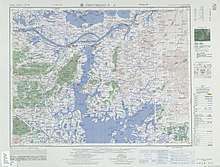
- Districts:
- Xunyang District (浔阳区)
- Lianxi District (濂溪区)
- Chaisang District (柴桑区)
- Counties:
- Wuning County (武宁县)
- Xiushui County (修水县)
- Yongxiu County (永修县)
- De'an County (德安县)
- Duchang County (都昌县)
- Hukou County (湖口县)
- Pengze County (彭泽县)
- Ruichang (瑞昌市)
- Gongqingcheng (共青城市). Directly administered as a sub-prefecture-level city since 1 July 2014.[4]
- Lushan (庐山市)
- Others
- Bureau
- Lushan Cultural Sites Administrative Bureau
- Development regions:
- Jiujiang Open Development Region, Gongqing Open Development Region
There are 235 towns and 11 sub-district offices.
| Map |
|---|
History
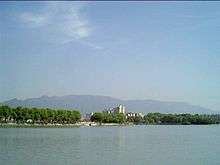
In ancient times it was told that nine rivers converged near where Jiujiang sprang up to become Jiangxi's main water port today. During the Xia through the Shang Dynasties the capitals of several states were located in area of Jiujiang. In the Spring & Autumn Period (770-476 BCE) Jiujiang bordered between the states of Wu (downstream, to the east) and Chu (upstream, to the west). Tao Yuanming (365-429 CE) a famous Chinese philosopher lived at the base of Lushan. He was once appointed magistrate of nearby Pengze County and after 83 days resigned due to the politics involved in administering justice. He retired back to his village to pen an essay called "Peach Blossom Spring". In 757, Li Bai (701-762 CE) was implicated in An-Shi disturbances and imprisoned at Jiujiang. Bai Juyi (772-846 CE) wrote a poem called "Lute Song", which is about his sadness and isolation of forced exile as a middle rank official to reside in such a small town. In the 13th century Zhu Xi was a Confucian philosopher who practiced at the White Deer Grotto Academy, on Lushan's eastern flanks.
Jiujiang has also been known as Jiangzhou and Xunyang in former times. During the Jin Dynasty (265-420) it was known as Sin Yang, the Liang dynasty (502-557) it was called Jiangzhou. The Sui Dynasty saw its name as Jiujiang and the Song Dynasty (960-1127) called it Ting Jiang. The Ming dynasty (1368–1644), gave it Jiujiang which has retained its name to this day. It was a Taiping rebellion stronghold for five years (1850–64) after they devastated the town to only leave one street with buildings intact. The city served as the capital of Taiping's Jiangxi province during this time.
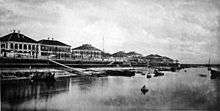
A member of Lord Elgin's committee arriving in 1858 to survey Chinese ports for treaty status noted: "We found it to the last degree deplorable." A single dilapidated street, composed only of a few mean shops, was all that existed of this once thriving populous city. The remainder of the vast area composed within its massive walls 9-10 kilometers in circumference, contained nothing but ruins, weeds and kitchen gardens. After becoming an open treaty port in 1862, it was exporting Jiangxi's vast rice crop. In 1904, more than 160,000 kilos of opium were moved through its customs house.
The New York Methodist Mission Society's Superintendent, Virgil C. Hart, arrived in Kiukiang in 1866 and bought a piece of property just east of the city wall. This is where the city's first Methodist Church and western hospital was built, with the hospital renamed the #1 Hospital, and the oldest/continuous operating hospital in Jiangxi Province.[5] In 1896 Drs. Mary Stone (Shi Meiyu) and Ida Kahn (Kahn Cheng) arrived back in Jiujiang, being China's first two native female western-educated doctors; having graduated from the University of Michigan Medical School. They were provided with funds collected by Dr. I. N. Danforth (from Chicago residents), to build the Elizabeth Skelton Danforth Hospital and administered entirely by the native Chinese. This was later renamed Jiujiang Women's and Children's Hospital, and the nursing education by Drs. Stone and Kahn would later be the impetus for the founding of Jiujiang University and Jiujiang Medical School.[6]
It became one of the three centers of the tea trade in China along with Hankou and Fuzhou. The Russians had two brick tea producing factories, but ceased operations after 1917. On October 16, 1927 there was an explosion of ammunition on the Chinese troopship Kuang Yuang near Jiujiang.[7] The British surrendered their concession in 1927 after being robbed and its Chinese workers mutineered their posts to the marauding crowds. An economic recession had set in over the decades as Indian and Chelonian tea made for greater competition. A military advance was being staged upriver in Wuhan by the Kuomintang in 1927 and all the remaining expatriate community fled on British and American warships towards safer waters of Shanghai, to never return.
Jiujiang languished as a port and much of its export trade was siphoned off with the connecting of Nanchang to coastal rail lines built in 1936–37. Until 1949 Jiujiang had very little industry except for local handicrafts. Manufacturing is Jiujiang's backbone today with auto, machinery, petrochemical, shipbuilding and textiles as its cornerstones. After the completion of the Yangtze River Bridge in 1992 and the Beijing to Kowloon (Hong Kong) and Wuhan to Shanghai rail systems laid, a convenient ground corridor was provided and a regional airport now serves most of China's capital cities.
The city suffered only slight damage in the 2005 Ruichang earthquake, but there were several deaths reported in outlying areas.
Demography
The city administers a total population of approximately 4,728,778 at the 2010 census of whom approximately 704,986 are urban living in the built-up area.[8] The population density is 249 per km². Han Chinese make up 99.8% of the population, but registered residents include representatives of 25 minority nationalities, including six with a local population of more than 100: Hui, Miao, Zhuang, Tujia, and She.
Unlike the Gan dialects typical of Jiangxi, the local speech of Jiujiang is a variety of Lower Yangtze Mandarin.
Climate
| Climate data for Jiujiang (1981−2010) | |||||||||||||
|---|---|---|---|---|---|---|---|---|---|---|---|---|---|
| Month | Jan | Feb | Mar | Apr | May | Jun | Jul | Aug | Sep | Oct | Nov | Dec | Year |
| Record high °C (°F) | 21.3 (70.3) |
29.1 (84.4) |
31.8 (89.2) |
34.1 (93.4) |
37.0 (98.6) |
38.6 (101.5) |
40.9 (105.6) |
40.9 (105.6) |
38.9 (102.0) |
35.6 (96.1) |
29.7 (85.5) |
22.8 (73.0) |
40.9 (105.6) |
| Average high °C (°F) | 7.9 (46.2) |
10.4 (50.7) |
14.8 (58.6) |
21.4 (70.5) |
26.8 (80.2) |
29.7 (85.5) |
33.5 (92.3) |
32.7 (90.9) |
28.3 (82.9) |
23.0 (73.4) |
16.8 (62.2) |
10.9 (51.6) |
21.3 (70.4) |
| Daily mean °C (°F) | 4.8 (40.6) |
7.0 (44.6) |
11.0 (51.8) |
17.3 (63.1) |
22.6 (72.7) |
25.9 (78.6) |
29.6 (85.3) |
28.7 (83.7) |
24.6 (76.3) |
19.2 (66.6) |
13.0 (55.4) |
7.2 (45.0) |
17.6 (63.6) |
| Average low °C (°F) | 2.5 (36.5) |
4.5 (40.1) |
8.2 (46.8) |
14.1 (57.4) |
19.3 (66.7) |
23.0 (73.4) |
26.5 (79.7) |
25.8 (78.4) |
21.8 (71.2) |
16.3 (61.3) |
10.1 (50.2) |
4.5 (40.1) |
14.7 (58.5) |
| Record low °C (°F) | −4.2 (24.4) |
−5.3 (22.5) |
−1.0 (30.2) |
3.6 (38.5) |
10.0 (50.0) |
14.5 (58.1) |
19.8 (67.6) |
17.8 (64.0) |
14.3 (57.7) |
5.6 (42.1) |
−0.7 (30.7) |
−6.7 (19.9) |
−6.7 (19.9) |
| Average precipitation mm (inches) | 72.1 (2.84) |
90.6 (3.57) |
141.3 (5.56) |
176.0 (6.93) |
184.6 (7.27) |
223.0 (8.78) |
156.8 (6.17) |
125.6 (4.94) |
72.8 (2.87) |
83.9 (3.30) |
75.0 (2.95) |
44.3 (1.74) |
1,446 (56.92) |
| Average relative humidity (%) | 75 | 75 | 76 | 75 | 74 | 78 | 73 | 76 | 76 | 73 | 73 | 71 | 75 |
| Source: China Meteorological Data Service Center[9] | |||||||||||||
Industry
Primary industries include
- Petrochemical refinement
- Agricultural chemical production
- Import/export (through river port)
Transport
Rail
Jiujiang is served by the Beijing-Kowloon, Tongling–Jiujiang, Hefei–Jiujiang, Wuhan–Jiujiang and Nanchang–Jiujiang Intercity Railway, via Jiujiang Railway Station.
Air
- Jiujiang Lushan Airport (JIU)
Yangtze River
The Yangtze River is used heavily for shipping. There is currently one bridge, the Jiujiang Bridge, that carries road and rail over the river. A second bridge, the Jiujiang Fuyin Expressway Bridge, is under construction that will carry traffic on the G70 Fuzhou–Yinchuan Expressway.
Colleges and universities
- Jiujiang University: Located farther out from the city center, it is most easily reached by the 101 bus from the center.
- Jiujiang Financial and Economic College: A small picturesque college located right by the lake and next to Walmart, this college is well situated within the city.
International relations
Twin towns — Sister cities
Jiujiang is twinned with:
|
|
Tourism
- Mount Lu, located in the south of the urban center, is listed as a world heritage site.
- Stone Bell Hill: Just downriver from Jiujiang is Hukou where the Yangtze River and waters of Boyang Lake converge with an abrupt color change. People have been coming here for centuries to listen to the stone-bell sound resonating from the cliffs overlooking this spot. A few theories are provided why this rare geographical phenomenon happens. Li Daoyuan from the Northern Wei period (386-534) theorizes that it is because the hill has a bell-shaped appearance and hollow inside, thus providing the sound when struck. Or it may be because of the water lapping within the limestone nooks and fissures around its base, as famous litterateur from the same time Su Shui discovered. Su Dongpo also did three trips around its perimeter, before settling on this last explanation for its unique sound also. Many Chinese literati's have left more than twenty calligraphy masterpieces carved upon its rocks, with some dating back to the Tang dynasty (618-907 CE).
- Xunyang Tower (simplified Chinese: 浔阳楼; traditional Chinese: 潯陽樓) is an ancient Chinese tower in Xunyang District,Jiujiang, Jiangxi Province, on the shore of Xunyang River.
It is one of the Ten Great Towers of Jiangnan.
- Nanshan Park (南山公园): Completed in early 2013, this park, home to a new pagoda, is covered in flora and lights up the Jiujiang sky at night.
External links
| Wikimedia Commons has media related to Jiujiang. |
References
- 地理交通 [Geography and transport] (in Chinese). Jiujiang People's Government. Retrieved 1 June 2018.
- Postal romanization
- "China's Top 10 Most Livable Cities". hnloudi.gov.cn. Hunan Loudi Official Government. 2012-03-28. Archived from the original on 2013-04-10. Retrieved 2014-08-04.
- 共青城市被列入省直管县改革试点 (in Chinese). People.com.cn. 29 May 2014. Retrieved 7 June 2018.
- "Man On A Mission" by Stanley Crawford
- "The Middle Kingdom's Miracle Maidens" by Stanley Crawford
- "1,200 Die as Yangtse Troopship Blows Up". The New York Times. October 17, 1926.
- http://www.citypopulation.de/php/china-jiangxi-admin.php
- 中国地面气候标准值月值(1981-2010) (in Chinese). China Meteorological Data Service Center. Retrieved 10 October 2019.
- "Interactive City Directory". sister-cities.org. Sister Cities International. Retrieved 24 October 2014.
- "Kajaani's twin towns". kajaani.fi. Kajaani. Archived from the original on 22 March 2015. Retrieved 24 October 2014.
